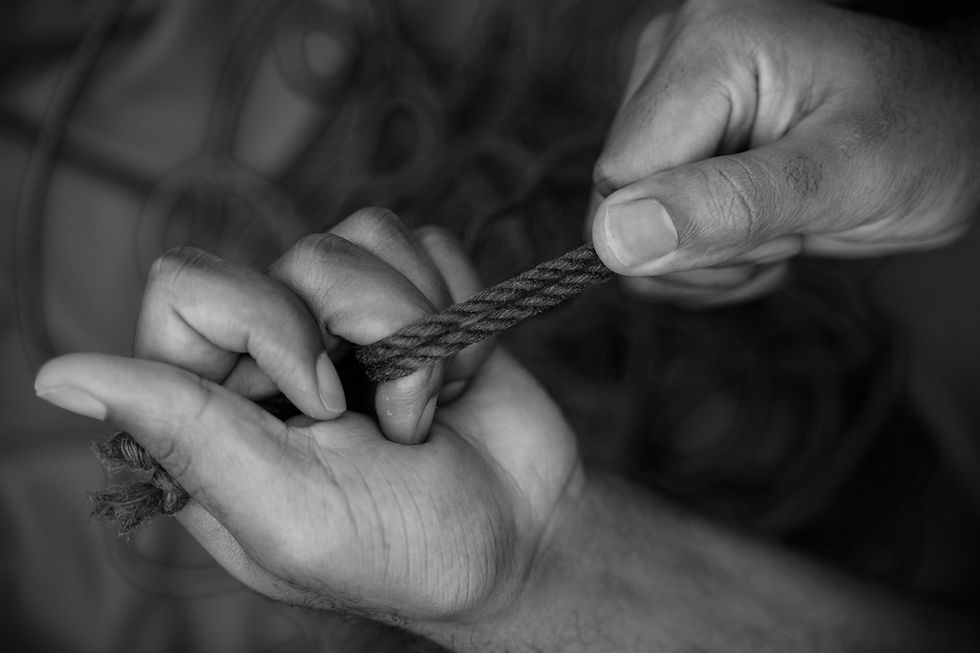Understanding the Role of a Sir in BDSM
- Moodtime Adult Store
- Oct 12, 2023
- 6 min read
Updated: Feb 1
A Comprehensive Guide - Dominance and Submission
BDSM, an acronym for Bondage, Discipline, Dominance, Submission, Sadism, and Masochism, encompasses a wide range of roles and dynamics that play out within the context of consensual power exchange. One of the pivotal roles in the BDSM community is that of a Sir. This article aims to shed light on what it means to be a Sir in BDSM and the responsibilities and dynamics that come with this role.
The Essence of Being a Sir in BDSM
In BDSM, a Sir typically refers to the dominant partner or person in a D/S (Dominance and Submission) relationship or play scenario. The title Sir is often used as a sign of respect and reverence within the BDSM community. While the title is most commonly associated with male dominants, it's important to note that dominants can be of any gender.
Respect and Consent: A Sir, like all dominants in BDSM, should prioritize respect and informed, enthusiastic consent above all else. The dominant partner must always ensure that their submissive partner is comfortable with the activities and dynamics involved.
Trust and Responsibility: Being a Sir is about establishing a foundation of trust with a submissive. A Sir must be responsible for their submissive’s physical and emotional well-being. This includes setting boundaries, respecting safe words, and ensuring that any BDSM activities are conducted safely.
Communication: Open and honest communication is paramount. A Sir should maintain a clear line of communication with their submissive. They should discuss desires, limits, and expectations. This open dialogue is essential for building a strong, trusting relationship.
Guidance and Training: Many submissive seek a Sir for guidance and training. A Sir often takes on the role of a mentor, teaching their submissive the intricacies of BDSM. This includes safe practices, techniques, and the psychological aspects of submission.
Punishment and Discipline: A key aspect of being a Sir is disciplining the submissive when necessary. However, this discipline should always be within the pre-established boundaries and never cross into abuse. It is about reinforcing discipline and maintaining the power dynamic.
Protector and Caregiver: A Sir is often seen as a protector and caregiver to their submissive. This includes aftercare, which involves providing emotional support and reassurance to the submissive after a BDSM session.
Understanding the Submissive: Each submissive is unique, and it is the Sir's responsibility to understand the submissive’s needs, desires, and triggers. Every D/S relationship is tailored to the individuals involved.
Safe, Sane, and Consensual (SSC): A Sir must adhere to the principles of SSC, ensuring that all BDSM activities are safe, sane, and consensual. This includes regular health check-ups and ensuring that all equipment is in good condition.
The Significance of Punishment and Discipline
The role of a Sir carries various responsibilities, and one essential aspect is punishment and discipline, a framework of discipline is to reinforce the power dynamic and maintain the submissive’ s obedience and submission. Punishment does not have to be physical; it is also crucial to understand that this discipline should always occur within the pre-established boundaries and never cross into abuse.
Maintaining Structure: Punishment and discipline create a structured environment within a BDSM relationship and submissive often thrive in well-defined roles with clear expectations.
Reinforcing Boundaries: It reminds the submissive of the agreed-upon boundaries and the consequences of crossing them, thus promoting self-awareness and respect for limits.
Power Exchange: Discipline is a tangible expression of the power exchange between the Sir and the submissive, emphasizing the Sir's authority and the submissive’s obedience.
Correction and Improvement: Punishments are not solely punitive but can also serve as opportunities for personal growth and improvement. They encourage the submissive to learn from their mistakes and evolve within the BDSM relationship.
Enhancing the Dynamic: For many BDSM enthusiasts, the interplay of punishment and forgiveness can intensify the emotional and psychological aspects of the dominant-submissive dynamic.
Examples of Punishment and Discipline
Spanking or Flogging: A classic form of physical discipline, spanking can range from sensual to painful, depending on the submissive’s preferences and the nature of the infraction.
Corner Time: Submissive may be required to stand or kneel in a corner for a specified period, fostering reflection and submission.
Writing Assignments: Assigning essays or lines for the submissive to write about their behaviour or transgressions.
Withdrawal of Privileges: A Sir can revoke certain privileges, such as the right to speak, move freely, or even engage in sexual activities, as a form of punishment.
Physical Restraints: Restraining the submissive as a punitive measure, emphasizing their lack of control.
Verbal Reprimands: Utilizing strong, commanding language to chastise the submissive for their actions or disobedience.
Humiliation Play: Humiliation, within established limits, can be used to discipline a submissive. It should be consensual and not genuinely hurtful.
Financial Control: A Sir may control the submissive’s finances or give them a strict budget as a means of discipline.
Time-Out: Similar to corner time, time-out involves a submissive taking a break to reflect on their behaviour.
Dominance and Submission
Punishment and discipline are integral components of the BDSM dynamic between a Sir and a submissive. They serve to structure the relationship, reinforce boundaries, and emphasize the power exchange. However, it is essential to remember that all forms of discipline should be consensual, occur within predefined boundaries, and never cross the line into abuse. Open communication, trust, and respect should always underpin any BDSM relationship, including the role of a Sir in disciplining a submissive.
The second most important role of a Sir is that of a protector and caregiver and we will also explore the concept of aftercare.
The Significance of Being a Protector and Caregiver
Emotional Security: A Sir plays a pivotal role in creating an emotionally secure environment for their submissive. The submissive must trust that their Sir will ensure their physical and emotional well-being during and after BDSM activities.
Safety and Consent: A Sir is responsible for upholding the principles of consent and safety. This means respecting boundaries, ensuring the use of safe words, and prioritizing the welfare of the submissive.
Communication and Trust: Effective communication is paramount in BDSM relationships. A Sir must foster open dialogue with their submissive, allowing them to express their needs, concerns, and desires without fear of judgment.
Aftercare: Aftercare is a crucial aspect of the protector and caregiver role. It involves providing comfort, reassurance, and physical care to the submissive after a BDSM session, helping them transition back to a state of emotional equilibrium.
Mental and Emotional Support: A Sir acts as a source of mental and emotional support for their submissive. They must be attuned to the emotional impact of BDSM activities and provide the necessary care to address any feelings of vulnerability, anxiety, or discomfort.
The Importance of Aftercare
Aftercare is an essential component of BDSM dynamics and highlights the protector and caregiver role of a Sir. Here are key points about aftercare:
Physical Care: After BDSM activities, a Sir may attend to any physical needs of the submissive, such as cleaning wounds, applying ointments, or providing water and nourishment.
Emotional Reassurance: Aftercare includes offering emotional support to the submissive. A Sir reassures the submissive of their care, affection, and the value they place on their well-being.
Cuddling and Affection: Physical closeness, such as cuddling and gentle caressing, can be a vital part of aftercare, offering comfort and a sense of security to the submissive.
Discussion and Debriefing: Aftercare often involves discussing the BDSM session, reflecting on the experience, and addressing any emotional or psychological reactions. This dialogue helps the submissive process their feelings and provides an opportunity for the Sir to offer further reassurance.
Time and Patience: A Sir should be patient and attentive during aftercare. The length and nature of aftercare can vary depending on the submissive’s needs and the intensity of the BDSM session.
Roles of the Submissive
The sub follows, pleases, or serves the Dom. They surrender power to the Dom. Handing that power is a precious gift given with full consent and freely. They have a desire to please their dominant and elevate their dominant’s needs above theirs. But it’s important to note that the sub isn’t “powerless.” In fact, they hold a lot of power. They establish the boundaries and limits at the outset. And they can end the scene at any time by saying their safe words.
The Sub
Expresses desire to please the dominant
Likes the feeling of being controlled
Offers act of service like doing tasks ordered by the dominant
Leaves all the decisions to the Dom
Is able to take pain (if agreed on) for punishments like spanking or flogging
What makes a good sub
Good subs follow commands and rules
Communicate openly about their comfort levels
Accept punishment if they disappoint their sir
Must always be appreciative of their sir
Regularly provide cage checks in terms of chastity
Conclusion:
Being a Sir in BDSM is a multifaceted role that requires a deep understanding of power dynamics, respect, and consent. It involves not only dominating but also nurturing, protecting, and guiding a submissive. The essence of being a Sir lies in the responsibility and care a dominant partner offers to their submissive, all within the framework of trust, open communication, and mutual respect.








Comments